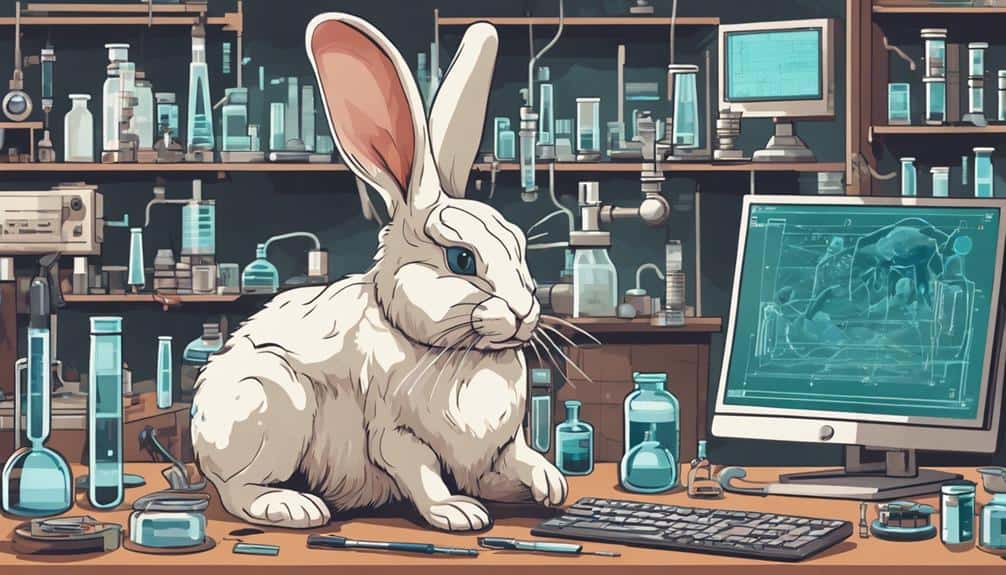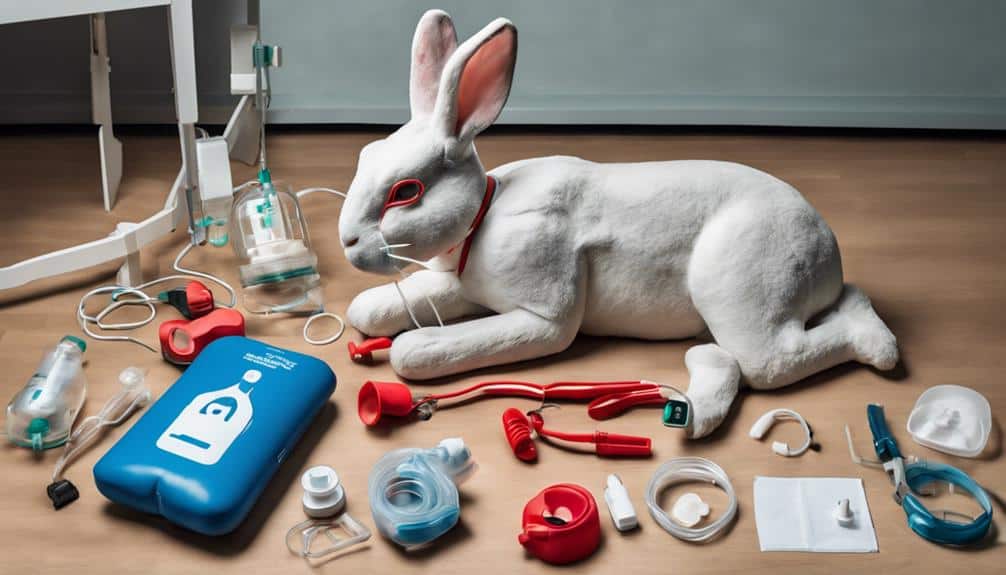If you've ever wondered if bunnies can come back to life after a seemingly dire situation, the answer may surprise you. Imagine witnessing a bunny's life hanging by a thread, only to witness a miraculous turn of events that leaves you in awe of nature's wonders.
The possibility of bunnies defying the odds and returning from the brink of death challenges our perceptions of life and its limits. But how exactly do these furry creatures manage to overcome such insurmountable odds?
Stay tuned to uncover the intriguing secrets behind the potential resurrection of bunnies and explore the fascinating world of animal survival.
Contents
- 1 Key Takeaways
- 2 The Science Behind Resurrection in Animals
- 3 Factors Influencing Bunny's Revival
- 4 Resuscitation Techniques for Bunny Survival
- 5 Understanding Bunny's Biological Resilience
- 6 Case Studies: Bunnies Defying Death
- 7 Exploring the Myth of Bunny Resurrection
- 8 Is It Safe to Leave My Bunny Alone for an Extended Period of Time?
- 9 Frequently Asked Questions
- 10 Conclusion
Key Takeaways
- Bunnies can be revived through immediate warming, monitoring vital signs, and essential care techniques.
- Survival mechanisms like suspended animation and recovery from distress situations showcase bunny resilience.
- Resuscitation, not resurrection, is achievable for bunnies in critical conditions.
- Swift action, CPR, and intensive care support are crucial for successful bunny revival post-cardiac arrest.
The Science Behind Resurrection in Animals

In understanding the science behind resurrection in animals, it's essential to recognize the remarkable physiological adaptations that certain species have evolved to survive extreme conditions. Bunnies, like other animals, possess incredible abilities to resuscitate under specific circumstances.
For instance, warm water can play a critical role in reviving bunnies that have experienced hypothermia. When a bunny is exposed to cold temperatures, its metabolism slows down, and its body temperature drops. Placing the bunny in warm water can help gradually raise its body temperature and stimulate its essential functions, aiding in its recovery.
This method isn't only applicable to bunnies but also to various other animals, showcasing the importance of understanding these techniques for overall pet health. By learning how to resuscitate animals like bunnies effectively, you can contribute to their well-being and potentially save lives in critical situations.
Factors Influencing Bunny's Revival
When considering factors that influence a bunny's revival, it's essential to focus on biological processes and environmental conditions.
The bunny's ability to recover may be impacted by how its body responds to resuscitation efforts and the surroundings it's in.
Understanding these elements can help guide the actions needed to give the bunny the best chance at coming back to life.
Biological Processes
Understanding the biological processes that influence a bunny's revival is essential for increasing their chances of coming back to life. When it comes to reviving bunnies, warming techniques play an important role in stimulating their natural biological processes. To effectively resuscitate a bunny, restoring their body temperature promptly is key.
Here are three key factors to take into account:
- Quick Response: Rapid warming methods can help reverse hypothermia and revive bunnies effectively.
- Vital Signs Monitoring: Monitoring vital signs and responding promptly to distress signals are important for successful bunny revival.
- Essential Care: Providing timely and essential care is crucial in supporting the biological processes needed for a bunny's revival.
Environmental Conditions
Consider the vital role environmental conditions, such as temperature and humidity, play in influencing a bunny's ability to revive. When attempting to resuscitate a baby bunny, providing the important environment is important for its chances of coming back to life. Here is a table outlining the key environmental factors that can impact the revival process:
| Environmental Condition | Importance |
|---|---|
| Temperature | Rapid warming using a heating pad can prevent irreversible damage. |
| Humidity | Maintaining a suitable level of moisture can aid in the bunny's resuscitation. |
| Water | Keeping the bunny hydrated is essential for its recovery post-revival. |
| Stress-free Environment | A warm, quiet space post-revival promotes the bunny's well-being. |
Resuscitation Techniques for Bunny Survival

To enhance the chances of survival for chilled baby bunnies, immediate warming techniques such as immersion in warm water or using a hair dryer can be crucial. When reviving baby bunnies, remember to dry them off really well to prevent any further chilling.
Here are some techniques to help resuscitate chilled bunny kits:
- Warm Towels: Placing warm towels around the bunnies can provide a gentle heat source to gradually raise their body temperature.
- Immersing Them in Warm Water: A warm water bath can help revive chilled bunnies by slowly raising their core temperature.
- Using a Hair Dryer: Gently blow warm air from a hair dryer on a low setting to help warm up the bunny kits without causing them distress.
Understanding Bunny's Biological Resilience
Bunnies possess remarkable regenerative abilities and survival mechanisms that enable them to bounce back from critical conditions like cardiac arrest.
Their biological resilience to external factors is truly fascinating, showcasing their ability to overcome seemingly insurmountable challenges.
Understanding these innate qualities can shed light on the extraordinary nature of bunnies' capacity to recover and thrive.
Bunny's Regenerative Abilities
Despite lacking regenerative abilities like some animals, bunnies possess remarkable biological resilience that enables them to recover from various challenges with proper care and intervention.
When faced with distress, bunnies exhibit extraordinary strength and resilience, showcasing their innate ability to bounce back from adversity. In times of need, their bodies can respond remarkably, displaying a persistence that defies the odds.
Through attentive observation and swift action, you can witness the incredible will to survive that bunnies harbor within them. Remember, every moment counts in providing the necessary support for these robust creatures.
- Swift response to distress signals
- Persistent fight for survival
- Robust nature in overcoming adversity
Survival Mechanisms in Bunnies
In emergencies, understanding the biological resilience of bunnies can be vital for aiding their survival. Bunnies possess remarkable survival mechanisms, such as the ability to enter a state of suspended animation to conserve energy under extreme stress. These furry creatures can also revive from hypothermia or near-death conditions with proper care. Despite appearing lifeless, some bunnies can be resuscitated through prompt intervention and warming techniques. This resilience extends to their capacity to recover from brain damage, showcasing their incredible adaptability in challenging situations. By comprehending these survival mechanisms, you can play a crucial role in helping bunnies bounce back from life-threatening scenarios.
| Survival Mechanism | Description |
|---|---|
| Suspended Animation | Bunnies can enter this state to conserve energy in times of extreme stress. |
| Hypothermia Resuscitation | Bunnies can be revived from hypothermia or near-death conditions with care. |
| Adaptability to Brain Damage | Bunnies showcase the ability to recover from brain damage in certain situations. |
Resilience to External Factors
When facing external factors, such as cold temperatures, a bunny's biological resilience becomes evident in their remarkable ability to withstand and recover from adverse conditions.
- Cold Kits: Bunnies can benefit from specialized kits designed to provide warmth and aid in resuscitating baby bunnies exposed to extreme cold.
- Back to Life: Despite appearing lifeless, bunnies have the inherent capacity to come back to life with the right care and intervention.
- Tool to Resuscitate Baby: Understanding the signs of distress and having the appropriate tools on hand can be essential in reviving baby bunnies from challenging situations.
Case Studies: Bunnies Defying Death
Through documented instances of bunnies defying death, remarkable stories have emerged showcasing their resilience in the face of cardiac arrest. These furry creatures have amazed many with their ability to bounce back from life-threatening situations. Immediate CPR and emergency measures have been crucial in saving bunnies that have suddenly stopped breathing. Intensive care and close monitoring have played a crucial role in their miraculous recovery. Here is a table highlighting some inspiring case studies of bunnies overcoming the odds:
| Case Study | Details | Outcome |
|---|---|---|
| Bunny 1 | Experienced full cardiac arrest | Successfully resuscitated, made full recovery |
| Bunny 2 | Stopped breathing suddenly | Revived with immediate CPR, thriving now |
| Bunny 3 | Showed resilience post cardiac arrest | Recovered faster than expected, resilient |
These instances emphasize the importance of swift action and care in ensuring the well-being of these delicate creatures. By learning from these cases, we can better understand how to support bunnies in times of crisis.
Exploring the Myth of Bunny Resurrection

Exploring the Myth of Bunny Resurrection reveals the fascinating intersection between folklore and the scientific understanding of biological processes. When it comes to the idea of bunnies coming back to life, it's crucial to separate myth from reality.
- Resuscitation vs. Resurrection: While resuscitation techniques can revive bunnies in critical conditions, bringing them back from death like in folktales isn't possible.
- Prompt Care Matters: Successful revival efforts require immediate attention and monitoring to prevent irreversible harm to the baby rabbits.
- The Dryer Myth: Despite stories of bunnies being revived after a trip in the dryer, the truth is that such scenarios are myths. Understanding the limits of resuscitation can help you manage expectations in emergency situations.
Is It Safe to Leave My Bunny Alone for an Extended Period of Time?
Leaving bunnies alone for an extended period of time can pose risks. Bunnies need supervision, regular meals, and social interaction. Consider a pet sitter or boarding facility for prolonged absences. Ensure their environment is secure and provide plenty of food and water.
Frequently Asked Questions
Is There a Way to Bring a Bunny Back to Life?
You can bring back a bunny to life by utilizing bunny revival techniques. Reviving pet rabbits involves warming, stimulation, and resuscitation efforts. Bringing back bunnies requires monitoring essential signs, providing warmth, and administering CPR effectively.
Can Bunnies Be Resuscitated?
You can resuscitate bunnies using warming techniques and animal CPR methods. Immediate care and monitoring are essential. With resilience and intense efforts, bunnies have shown miraculous recovery, standing up and thriving after critical situations.
How Long Do Bunnies Stay in Shock?
When bunnies experience shock, their behavior changes, showing signs like rapid breathing and weakness. It's important to act fast in emergency situations to stabilize their health. Immediate care is essential for their recovery.
How Do You Resuscitate a Rabbit?
When a bunny needs resuscitation, act swiftly. Employ CPR techniques, apply first aid measures, and have an emergency response plan. Stay vigilant for signs of distress and monitor for recovery. Your care can make a difference.
Conclusion
You may be skeptical about the idea of bunnies coming back to life, but the science and real-life stories speak for themselves. With the right knowledge, techniques, and care, these resilient creatures can defy the odds and make miraculous recoveries.
By staying informed and prepared, you can be ready to help a bunny in need and witness the amazing potential for revival in these small, but mighty animals. Stay informed, stay compassionate, and believe in the power of bunny resilience.






